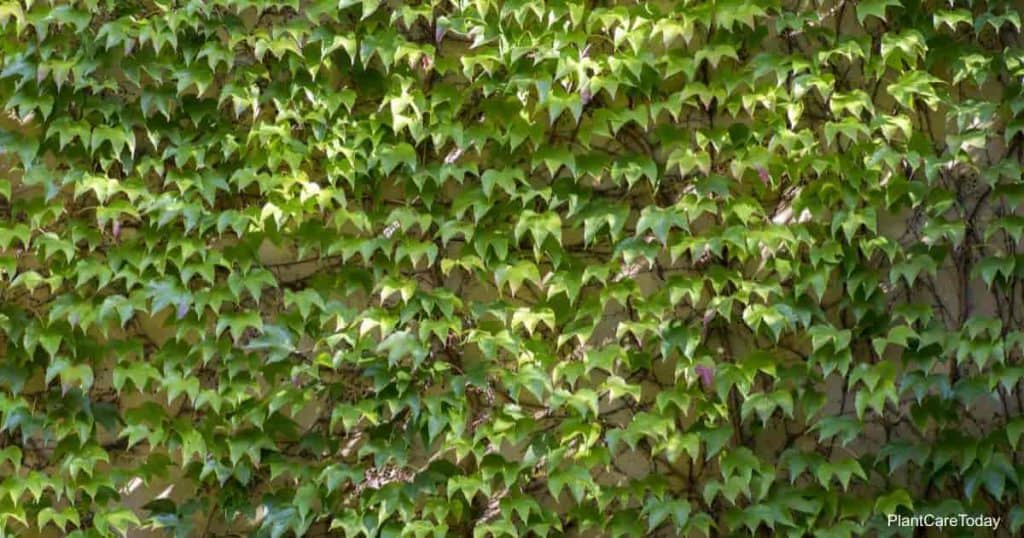The Virginia creeper vine is one of the prettiest plants that belong to the grape family, which makes it quite attractive to have around your household.
This drove many people to ask, “Is Virginia creeper poisonous?” in this article, you’ll find the detailed answer!

The Virginia Creeper, also goes by the botanical name “Parthenocissus quinquefolia”, is a species of decorative ivy plant.
In fact, some people might confuse the plant with poison ivy leaf due to the resemblance between them.
The plant has got because Virginia is one of the native locations of the plant. However, the plant is also native to central and eastern North America, from southeast Canada to Mexico and Guatemala.
In addition to Virginia Creeper, it has some other names, such as:
- The five-leaved ivy
- The five fingers
- Thicket creeper
- American Ivy
- False grapes
- Woodbine
- Woodbind
Virginia creepers grow very rapidly, and their foliage turns its bright red and burgundy color during the fall, which is why a lot of people use them for ornamental and decorative purposes outside their houses.
Since the plant is regularly confused with poison ivy (which has 3 finger leaves instead of 5), here’s what you need to know about the Virginia creeper’s toxicity
Is Virginia Creeper Poisonous To Touch?
Despite being one of the most attractive plants out there, you should always admire the Virginia creeper from a safe distance from children.
But is virginia creeper poisonous to dogs and cats as well?
Yes. Keep your pets away from it. According to various sources, the Virginia creeper is a very toxic plant to humans and animals.
The United States Department of Agriculture warns against eating them because they can be fatal to humans. In fact, the same source also claims that touching them is enough to cause skin issues.

In addition to humans, cats, dogs, and horses are also at risk of poisoning upon ingesting the Virginia creeper.
Most birds and other animals might not get poisoned if they ingest the plant. However, the toxic effects of Virginia creeper were noticed on budgerigars when they were fed the leaves. So, it can also be poisonous to pet birds.
The creeping virginia plant produces large amounts of calcium oxalate crystals known as (raphides).
These crystals are ones that accumulate in the kidneys and are known as “kidney stones.” Ingesting oxalate crystal is also proven by clinical studies to cause acute kidney failure.
What Parts Of The Virginia Creeper Are Poisonous or Toxic?
Almost all parts of the Virginia creeper can be poisonous. The plant, in general, has toxic levels of oxalate crystal that’s responsible for its toxicity.

The parts containing the most oxalate crystals are the berries and leaves, which is why it can be fatal to eat them.
Some reports also claim that the sap produced by the plant contains very irritating oxalate crystals when they come in contact with the skin.
What Are The Symptoms Of Virginia Creeper Poisoning?
The symptoms of Virginia creeper poisoning depend mainly on the method of contact with the plant.
For example, touching the carolina creeper plant might not be fatal, but it can cause a strong skin reaction in the form of itching and rash.
This is because oxalate crystals are shaped like needles with very sharp edges under the microscope. These edges keep pricking the skin, causing irritation and burning.
Note: The Dieffenbachia plant is also known for its oxalate crystals.

If you’re exposed to the oxalate-rich sap, make sure that you flush the area with large amounts of water or rinse it for some time to ease the irritation.
The most dangerous part of the plant is its berries. They’re bright in color and look like grapes, which makes them appealing to pets and young children.
Related: What Plants are Toxic to Cats?
If humans or pets chew on the berries, they’ll start to feel some burning sensation around their lips and the inner walls of their mouths.
Ingesting the berries might cause a gastroenteritis allergic reaction and vomiting in humans and pets.
How To Protect Yourself While Handling Virginia Creeper
As you know, Carolina creeper vine can be quite dangerous to handle because their sap and leaves are rich in irritating oxalate crystals.
For that reason, it’s extremely critical that you always wear proper protective gear to prevent the toxic parts from coming in contact with your skin.
This includes gloves for handling, eye protection, and long durable boots if you’re walking in a field where Virginia creeper foliage is present.

Unlike poison ivy, the five-fingered creeper doesn’t produce irritating oil, so you won’t have to worry about lung irritation if you burn leaves.
However, you should avoid inhaling the fumes of Poisonous virginia creeper anyway because of the toxic carbon monoxide they can produce, which can cause suffocation and or even death in confined spaces.